There are several commercial systems you can buy in which to steam your silk. This artist cleverly built her own using a turkey roaster and a stove pipe. The instructions for layering art work between newsprint and/or cotton sheeting must be used for all steamers.
Step-by-Step Steaming Process
- Layer scarves or art work on unprinted newspaper print (end-rolls from a small newspaper business), using 2 lengths of newsprint between each set of scarves. In this case, 6 scarves are being steamed, 2 per layer. If steaming only one layer of silk, 4-6 layers of newsprint is recommended. When using black dye, 3-4 layers of newsprint are usually necessary between layers.The coil is "hardware" fencing from a Menards/Lowe’s store. Use thick gloves and a big wire cutter to assemble the coil around a broomstick. The coil gets rusty, so make sure it is covered with the newsprint before rolling
- Three layers (6 scarves) are now laid out on the paper. When using soy wax as in this case, the 2 newsprint layers will absorb most of the wax and eliminate the need to iron the wax out. These are commissioned pieces for a Visitor’s Bureau in Iowa. Note the "skyline" effect on the scarf ends.
- Using the coil, start tucking the newsprint around it. Place a 2 X 4 wooden board with tape in front of the coil. It flattens the scarf roll as it is rolled up. Remember to keep the bundle as tight and as straight as possible on the coil.
- Here is the rolled scarf bundle with the coil out on both sides. Use masking tape to secure the flaps of newsprint.
- Now, take more masking tape to secure the bundle to the coil, all the way around the length and over the coil itself. This is to secure the bundle and keep it at its safest place during steaming.
- Cotton bags were made to hold the bundle in the steamer. The rusty spots on the top of the bag are the holes for the supporting rod.
- The black paper clips are used ¾ of the way toward the bottom of the bundle. These are to keep the bundle off of the sides of the steamer. The thin metal supporting rod goes through the bag, the masking tape and the coil (NOT THE SILK) and then out the other side.
- Aluminum foil is used to prevent steam/bubbles from reaching the bottom of the bundle.
- This steamer is a home-made version of the Dharma vertical steamer. The heating base is a turkey roaster purchased at Wal-Mart. Stove pipe was used to form the main part of the steamer. The stove pipe and the roaster were taken to a furnace/ heating business. The service department used the liner (removable part where the turkey goes) and the lid/cover with the handle to make the bottom part of the vertical steamer. There is an insulation layer around the stove pipe. The indentions in the insulation are the side handles, necessary for inserting and removing the stove pipe from the heating portion of the roaster. Add water, at least three inches deep and allow pre-heating time.
- The bundle is placed in the stove pipe with the thin metal rod resting in notches cut in the top of the stove pipe.
- Two towels are placed on top to absorb the steam. The temperature is set at the highest level. It takes about 20 minutes for steam to come out the top. The water does not reach a rolling boil. The test for temperature is the amount of steam coming out the top, which then is kept in the steamer as much as possible by the towels.
- See how the wax has been absorbed by the newsprint. The newsprint is not reusable.
- Notice the interesting shapes due to wax application.
- Scarves are allowed to dry over night.
- Scarves are washed in Synthrapol and rinsed until the water is clear. Downey (hair conditioner can also be used in a pinch) is used to soften and condition the silk.
- This step has been proven to be essential in preventing excess dye from back staining itself. The scarves are place on toweling and rolled. These lengths of terry toweling were purchased from a fabric store and cut the long way. They have saved the day from the back-staining issue, especially when using black and lighter colors in the same silk piece. After a couple of hours in the terry toweling, the scarves can be removed and ironed. Or, instead of using the towels, hang them to dry one by one and iron while damp. At that time, use a diluted spray starch to bring back some of the body in the silk (optional).
|
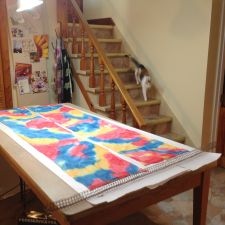
This steaming process described and photographed by Becky Kyhl
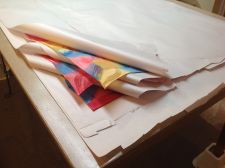
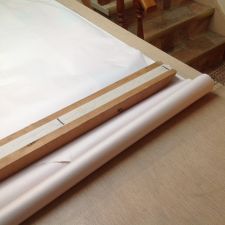
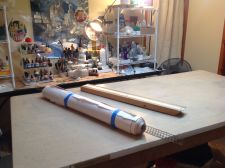
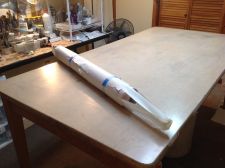
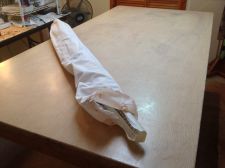
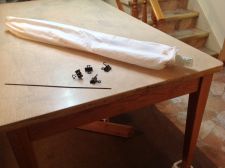
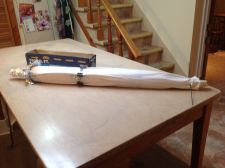
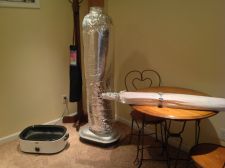
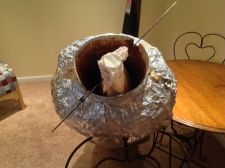

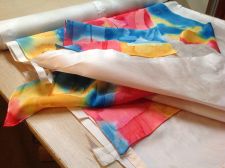
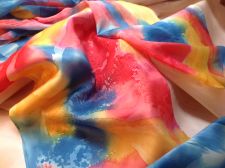
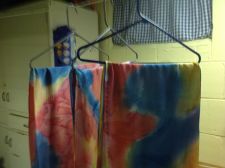

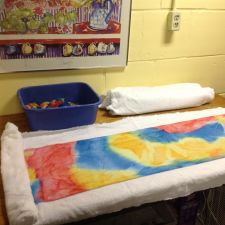
|















